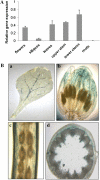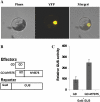MYB75 functions in regulation of secondary cell wall formation in the Arabidopsis inflorescence stem
- PMID: 20807862
- PMCID: PMC2971618
- DOI: 10.1104/pp.110.162735
MYB75 functions in regulation of secondary cell wall formation in the Arabidopsis inflorescence stem
Abstract
Deposition of lignified secondary cell walls in plants involves a major commitment of carbon skeletons in both the form of polysaccharides and phenylpropanoid constituents. This process is spatially and temporally regulated by transcription factors, including a number of MYB family transcription factors. MYB75, also called PRODUCTION OF ANTHOCYANIN PIGMENT1, is a known regulator of the anthocyanin branch of the phenylpropanoid pathway in Arabidopsis (Arabidopsis thaliana), but how this regulation might impact other aspects of carbon metabolism is unclear. We established that a loss-of-function mutation in MYB75 (myb75-1) results in increased cell wall thickness in xylary and interfascicular fibers within the inflorescence stem. The total lignin content and S/G ratio of the lignin monomers were also affected. Transcript profiles from the myb75-1 inflorescence stem revealed marked up-regulation in the expression of a suite of genes associated with lignin biosynthesis and cellulose deposition, as well as cell wall modifying proteins and genes involved in photosynthesis and carbon assimilation. These patterns suggest that MYB75 acts as a repressor of the lignin branch of the phenylpropanoid pathway. Since MYB75 physically interacts with another secondary cell wall regulator, the KNOX transcription factor KNAT7, these regulatory proteins may form functional complexes that contribute to the regulation of secondary cell wall deposition in the Arabidopsis inflorescence stem and that integrate the metabolic flux through the lignin, flavonoid, and polysaccharide pathways.
Figures





References
-
- Bernhardt C, Lee MM, Gonzalez A, Zhang F, Lloyd A, Schiefelbein J. (2003) The bHLH genes GLABRA3 (GL3) and ENHANCER OF GLABRA3 (EGL3) specify epidermal cell fate in the Arabidopsis root. Development 130: 6431–6439 - PubMed
-
- Bloom AJ, Chapin FS, III, Mooney HA. (1985) Resource limitation in plants-an economic analogy. Annu Rev Ecol Syst 16: 363–392
-
- Brown DM, Zhang Z, Stephens E, Dupree P, Turner SR. (2009) Characterization of IRX10 and IRX10-like reveals an essential role in glucuronoxylan biosynthesis in Arabidopsis. Plant J 57: 732–746 - PubMed
Publication types
MeSH terms
Substances
LinkOut - more resources
Full Text Sources
Molecular Biology Databases
Research Materials

